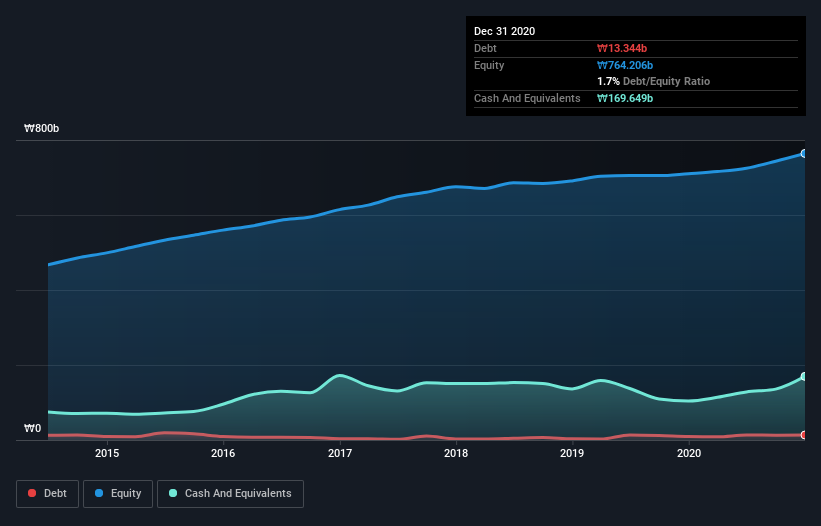- South Korea
- /
- Electrical
- /
- KOSE:A025540
Korea Electric Terminal (KRX:025540) Could Easily Take On More Debt

Legendary fund manager Li Lu (who Charlie Munger backed) once said, 'The biggest investment risk is not the volatility of prices, but whether you will suffer a permanent loss of capital.' It's only natural to consider a company's balance sheet when you examine how risky it is, since debt is often involved when a business collapses. We note that Korea Electric Terminal Co., Ltd. (KRX:025540) does have debt on its balance sheet. But the more important question is: how much risk is that debt creating?
What Risk Does Debt Bring?
Debt and other liabilities become risky for a business when it cannot easily fulfill those obligations, either with free cash flow or by raising capital at an attractive price. Part and parcel of capitalism is the process of 'creative destruction' where failed businesses are mercilessly liquidated by their bankers. However, a more frequent (but still costly) occurrence is where a company must issue shares at bargain-basement prices, permanently diluting shareholders, just to shore up its balance sheet. Of course, plenty of companies use debt to fund growth, without any negative consequences. When we think about a company's use of debt, we first look at cash and debt together.
See our latest analysis for Korea Electric Terminal
What Is Korea Electric Terminal's Debt?
You can click the graphic below for the historical numbers, but it shows that as of December 2020 Korea Electric Terminal had ₩13.3b of debt, an increase on ₩9.39b, over one year. However, it does have ₩169.6b in cash offsetting this, leading to net cash of ₩156.3b.

How Healthy Is Korea Electric Terminal's Balance Sheet?
According to the last reported balance sheet, Korea Electric Terminal had liabilities of ₩163.4b due within 12 months, and liabilities of ₩57.6b due beyond 12 months. Offsetting this, it had ₩169.6b in cash and ₩203.0b in receivables that were due within 12 months. So it actually has ₩151.7b more liquid assets than total liabilities.
It's good to see that Korea Electric Terminal has plenty of liquidity on its balance sheet, suggesting conservative management of liabilities. Due to its strong net asset position, it is not likely to face issues with its lenders. Simply put, the fact that Korea Electric Terminal has more cash than debt is arguably a good indication that it can manage its debt safely.
Even more impressive was the fact that Korea Electric Terminal grew its EBIT by 135% over twelve months. That boost will make it even easier to pay down debt going forward. There's no doubt that we learn most about debt from the balance sheet. But you can't view debt in total isolation; since Korea Electric Terminal will need earnings to service that debt. So when considering debt, it's definitely worth looking at the earnings trend. Click here for an interactive snapshot.
Finally, a business needs free cash flow to pay off debt; accounting profits just don't cut it. While Korea Electric Terminal has net cash on its balance sheet, it's still worth taking a look at its ability to convert earnings before interest and tax (EBIT) to free cash flow, to help us understand how quickly it is building (or eroding) that cash balance. Over the last three years, Korea Electric Terminal reported free cash flow worth 10% of its EBIT, which is really quite low. That limp level of cash conversion undermines its ability to manage and pay down debt.
Summing up
While we empathize with investors who find debt concerning, you should keep in mind that Korea Electric Terminal has net cash of ₩156.3b, as well as more liquid assets than liabilities. And it impressed us with its EBIT growth of 135% over the last year. So is Korea Electric Terminal's debt a risk? It doesn't seem so to us. The balance sheet is clearly the area to focus on when you are analysing debt. However, not all investment risk resides within the balance sheet - far from it. Be aware that Korea Electric Terminal is showing 2 warning signs in our investment analysis , and 1 of those is concerning...
If you're interested in investing in businesses that can grow profits without the burden of debt, then check out this free list of growing businesses that have net cash on the balance sheet.
When trading stocks or any other investment, use the platform considered by many to be the Professional's Gateway to the Worlds Market, Interactive Brokers. You get the lowest-cost* trading on stocks, options, futures, forex, bonds and funds worldwide from a single integrated account. Promoted
Valuation is complex, but we're here to simplify it.
Discover if Korea Electric Terminal might be undervalued or overvalued with our detailed analysis, featuring fair value estimates, potential risks, dividends, insider trades, and its financial condition.
Access Free AnalysisThis article by Simply Wall St is general in nature. It does not constitute a recommendation to buy or sell any stock, and does not take account of your objectives, or your financial situation. We aim to bring you long-term focused analysis driven by fundamental data. Note that our analysis may not factor in the latest price-sensitive company announcements or qualitative material. Simply Wall St has no position in any stocks mentioned.
*Interactive Brokers Rated Lowest Cost Broker by StockBrokers.com Annual Online Review 2020
Have feedback on this article? Concerned about the content? Get in touch with us directly. Alternatively, email editorial-team (at) simplywallst.com.
About KOSE:A025540
Korea Electric Terminal
Manufactures and sells parts for automotive and electronics in South Korea and internationally.
Undervalued with solid track record.
Similar Companies
Market Insights
Community Narratives



